Rumbling above, Bubbling below: Tokyo's Only Private Highway
The Construction Series > Earthquake >Small > Ginza > Circular > Earth > Underground
To the Captain, Ginza usually brings to mind two things: booze and hostesses. And when he mixes the two, there is often a third: the back seat of a squad car.
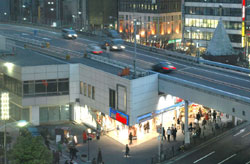 But this week he is in Tokyo's most renowned shopping quarter to profile a private highway. Jump in back - this time the Captain is at the wheel.
But this week he is in Tokyo's most renowned shopping quarter to profile a private highway. Jump in back - this time the Captain is at the wheel.
A steady hum and an occasional small shake or two rolls through the second floor office of Masaki Negishi, chairman of Tokyo Kosoku Doro Co. (Tokyo Expressway). The company's centerpiece is the reason for the rumbling: an elevated, U-shaped freeway that boxes in Tokyo's glittering Ginza shopping district on three sides.
Financed without government assistance and lacking any toll collection, the freeway's operating revenue is sourced from the rent of three floors of businesses housed within buildings directly below its pavement. For Tokyo, it is the only private motorway in the metropolis.
"The top is public," explains Negishi, whose office is squashed into the second floor of the Kita Yuraku Building. "The bottom is private. To keep everyone happy is quite a challenge."
Negishi and Tokyo Expressway have been balancing the effects of the moving traffic above with the tenants below - neither of whom is likely aware of the other - for forty years. During this time he has developed a few pointers for going private, a move the government has partially implemented for its national highway system.
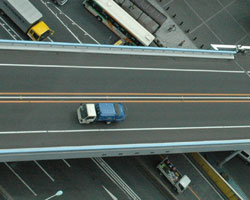 Tokyo Expressway's thoroughfare, which generally alternates between one and two lanes in both directions, provides a link between Ueno to the north and Haneda Airport to the south. Its asphalt has a total of 40,000 vehicles motoring over it daily.
Tokyo Expressway's thoroughfare, which generally alternates between one and two lanes in both directions, provides a link between Ueno to the north and Haneda Airport to the south. Its asphalt has a total of 40,000 vehicles motoring over it daily.
More than 400 establishments - such as, restaurants, bars, offices, and parking structures - are housed in 14 buildings strung together by 13 bridges over the highway's 2-kilometer length.
The company is a diverse conglomerate of investors representing some of Japan Inc.'s giants: advertising behemoth Dentsu, retailer Takashimaya, newspaper empire Yomiuri, and general contractor Taisei Construction.
The group, established in 1951, put up the funds for the project's construction entirely on its own after negotiating a use agreement with the Tokyo government.
Construction began in 1953 at the centrally located Yamashita Building, which today is snug up against the Tokaido Shinkansen tracks. The Nishi-Dobashi Building next to it features a swank oyster bar, a Mandarin Chinese restaurant, and a post office.
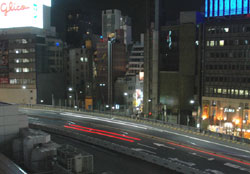 To that point, Ginza had been a canal and river district. Murky bogs with rickety wooden shacks lining their banks were common sights. Tokyo Expressway's project generally follows the path of sections of former waterways. Box culverts buried just at the edge of the structure now conceal flowing water.
To that point, Ginza had been a canal and river district. Murky bogs with rickety wooden shacks lining their banks were common sights. Tokyo Expressway's project generally follows the path of sections of former waterways. Box culverts buried just at the edge of the structure now conceal flowing water.
Bridges crisscrossed the canals for access. The Soto-bori canal was crossed the two-arch Sukiyabashi bridge to form one of Tokyo's more scenic spots for tourists in the pre-World War II days.
"At first," Negishi remembers of the company's early days, "there was a lot of opposition to the construction, but many of the people who were against it are now our tenants."
The road's width varies from 12 to 33 meters, with its surface rising 7.5 meters off ground level. Inside the buildings, many tenants fill their shelves with top brand products in such landmark shopping malls as Nishi Ginza and Ginza 5, while most building exteriors are styled in the art deco standards of chrome and neon.
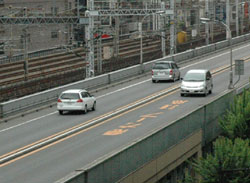 The freeway was up and running over its full length by 1966. An arterial at the bend formed by the Kita Yuraku Building near JR Yurakucho Station was completed in 1973.
The freeway was up and running over its full length by 1966. An arterial at the bend formed by the Kita Yuraku Building near JR Yurakucho Station was completed in 1973.
Negishi has confidence in his structure's ability to survive a substantial earthquake, this in spite of the fact that freeways in the port city of Kobe experienced collapsed bridge spans and buckled columns during the 7.2-Richter scale intensity Great Hanshin Earthquake in 1995.
"At the time we did our work, people were honest and always used the best steel and concrete," he says, hinting at the lack of ethics that is rife within Japan's construction industry. "Things became corrupt after the Tokyo Olympics in 1964."
As well, all the bridge abutments of Tokyo Expressway's structure were reinforced against collapse to meet newly implemented standards in the year following the Kobe disaster.
Annual maintenance costs run approximately 1.7 billion yen. Though vehicles are limited to 4 tons, cracks and potholes in the asphalt surface are common concerns that need to be addressed immediately due to the potential for leaks and an increase in noise.
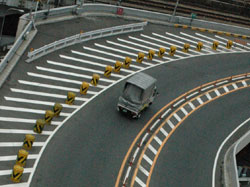 Noise and vibrations, as small as they may be, are common complaints from customers.
Noise and vibrations, as small as they may be, are common complaints from customers.
"If there's a hole or crack," Negishi says, "we have to respond to that right away. The people below have a business to run. At some of these places, customers are drinking until 4 a.m. So our window to work is very small."
One structural design flaw is the lack of a space between the bottom of the road and the businesses on the upper floor. This makes maintenance difficult and expensive.
"In speaking with the developers of a similar project in Osaka," Negishi relates, "I explained that they would save a lot of money by separating the two entities. This would protect against excessive vibrations and ease maintenance for leaks."
Last year, Japan's four government-owned highway authorities, whose debt totaled 44 trillion yen, were split into 6 "private" corporations in order to make them profitable and reduce the wasteful "pork" projects that often arise through political connections.
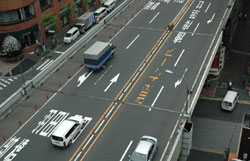 Critics have claimed that this separation is a ruse in that the determination of the road tolls, the appointment of directors, and the ability to sell assets are still in firm control of the government. As well, there are no plans for any of the corporations to be listed on a stock exchange.
Critics have claimed that this separation is a ruse in that the determination of the road tolls, the appointment of directors, and the ability to sell assets are still in firm control of the government. As well, there are no plans for any of the corporations to be listed on a stock exchange.
Negishi feels that such attempts at privatization will fail if the government merely changes the name of the organization and not their personnel and financial structure.
"From the beginning," he says, "we were concerned with how to make money, but bureaucrats are only concerned with how to spend it."
Business is good for Tokyo Expressway. It boasts a vacancy rate of less than 2%. An available 100-square-meter space recently resulted in their offices being swamped by 183 lease applications.
"We don't charge the highest rent we can get," Negishi says. "We are looking for quality and stability. We don't want our tenants to be changing all the time."
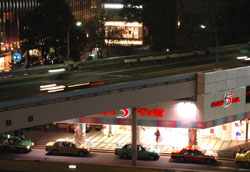 The high demand, he insists, is a product of the cachet attached to the area; the road may meander through addresses for Yurakucho and Shimbashi but the public recognizes it as "The Ginza" - perhaps the most highly regarded shopping district in all of Japan.
The high demand, he insists, is a product of the cachet attached to the area; the road may meander through addresses for Yurakucho and Shimbashi but the public recognizes it as "The Ginza" - perhaps the most highly regarded shopping district in all of Japan.
In addition to monitoring the road, Tokyo Expressway's 80 employees collect the rents (3 billion yen annually) for the 100,000 square meters of total tenant space, and send out bills for clean-up costs to drivers who have caused road accidents.
It is not uncommon for bars or restaurants to be crammed beneath train tracks in Tokyo, but the company's existence via a toll-free road is indeed unique.
Negishi, who started in the firm's accounting section, doesn't foresee any changes to the operation. Essentially, he's in cruise control.
"I don't have a problem with revenue," he says, "only vibrations."
The Construction Series > Earthquake >Small > Ginza > Circular > Earth > Underground

